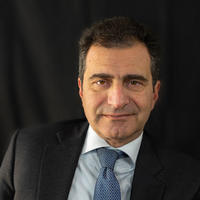Papers by Moorthy Srinivasa Muthuswamy
Physical review, Jul 1, 1992
Physics Letters B, 1990
We have initiated a search for strange quark matter in the products of 14.6 GeV/c per nucleon 28S... more We have initiated a search for strange quark matter in the products of 14.6 GeV/c per nucleon 28Si collisions with nuclei, utilizing the apparatus of E-814 at Brookhaven National Laboratory's AGS. We report the first results of this search, which is sensitive to particles with charge-to-mass ratios between 0.1 and 0.3 (GeV/c 2) -~ that are produced within approximately _+ 0.5 units of the center of mass rapidity.
Physical Review Letters, 1993
We present a systematic study of transverseenergy (ET) production in collisions of 11. 4A GeV/c A... more We present a systematic study of transverseenergy (ET) production in collisions of 11. 4A GeV/c Au and 14. 6A GeV/c Si ious with targets of Al, Au, and Pb. Comparison of data for Au+ Au and Si+ Al indicates that, for the heavier system, there is an increase in the amount of stopping which is accompanied by a decrease in the width of the dET/dry distribution. The ratio of the maximum ET observed for the two systems is significantly greater than the ratioof the total energy available in the center of mass frame.
Physical Review C, 1995
In the last few years, studies of heavy-ion reactions at high energy have provided new insight in... more In the last few years, studies of heavy-ion reactions at high energy have provided new insight into the production of nuclear matter at high baryon density and temperature. The main goal of this research is to evidence and study the expected new phase of nuclear rnatter that would result from the deconfinement of the quarks and gluons. To understand the signatures resulting from the production of this new form of nuclear matter (or any new phenomenon) and to succeed in deducing its properties, it is important that we have a ...
Physical Review C, 1995
Data from fragmentation studies have been a valuable source of information used to better underst... more Data from fragmentation studies have been a valuable source of information used to better understand the com-position of cosmic rays [1], to aid the search for exotic nu-clei and, recently, to study the production of secondary exotic nuclear beams [2]. In the past few years, heavy ion beams with ultrarelativistic energies have become available at the CERN-SPS and BNL-AGS accelerators. These facilities provide a unique opportunity to investi-gate projectile fragmentation in an energy regimewhere data is rather scarce. Ideas and ...
Physical Review C, 1995
ABSTRACT
Nuclear Physics A, 1992
We have used the E814 apparatus to make a systematic study of antiproton production in collisions... more We have used the E814 apparatus to make a systematic study of antiproton production in collisions of 28Si ions at 14.6 GeV/c per nucleon with targets of Pb, Cu, and Al. We have measured the antiproton yield per interaction as a function of transverse energy and have found the yield to increase by a factor of≈ 2 in going from the least to the most central collisions on the Pb target. A simple first-collision picture of antiproton production predicts the yield to increase by a factor of≈ 11. We suggest that the discrepancy may result from ...
Nuclear Physics A, 1997
The production of pions, protons and deuterons is studied at a laboratory angle of 144° in 28Si+ ... more The production of pions, protons and deuterons is studied at a laboratory angle of 144° in 28Si+ Pb collisions at 14.6 GeV/c per nucleon. The centrality dependence of the pion yields is studied over the full impact parameter range using a zero degree calorimeter. The results are compared with the hadronic cascade model RQMD. These calculations are generally in agreement with the experimental results. According to these calculations, the pion yield in our acceptance is completely dominated by Δ-decay at freeze-out. Our measurements ...

Social Science Research Network, Nov 2, 2015
As non-state actors, Muslim religious leaders have become very influential in many communities th... more As non-state actors, Muslim religious leaders have become very influential in many communities through the non-violent action of popularizing sharia narratives. This is despite the fact that these leaders had much less influence about 50 years ago, thanks to the encroaching modernity. However, beginning in the 1970s, thanks to Saudi Arabia’s backing, they began growing in power due to the popularization of a self-serving theme that sharia is all-encompassing divine law and an essential guide to life. As a result, sharia, too, grew in popularity worldwide. A new analysis of the 2003 Pew data tells us that religious leaders’ political and religious influences correlate with that of sharia. Calling the sharia bluff as a core part of a counterterrorism strategy – the Pew data tells us – is central to undermining the influence of radical religious leaders and the ideology of radicals.

Social Science Research Network, 2021
Salafi (Islamist) extremism, embraced by organizations such as the Islamic State, is a global phe... more Salafi (Islamist) extremism, embraced by organizations such as the Islamic State, is a global phenomenon whose primary cause is not clearly elucidated in the literature. Unlike most existing models or explanations of terrorism that attempt to explain stages or factors associated with the radicalization of individuals, the proposed theory aims to identify the dominant causal pathway behind the onset of Salafi extremism. Kosovo was used as a control group to establish Saudi Arabia-originated Wahhabism’s dominance as a radicalization source. The theory’s independent, dependent, and causal variables are public support levels for religious leaders as religious judges, the radical agenda they espouse, and the idea of Sharia as the law of the land, respectively. For nearly 20 nations listed in a 2013 Pew survey report titled “The World’s Muslims: Religion, Politics and Society,” the computed coefficients of determination for the public support levels for religious leaders and a radical agenda, Sharia and religious leaders, and Sharia and a radical agenda, were 0.83, 0.85, and 0.86, respectively, using linear regression methodology. The belief in Sharia as the law of the land, as advocated by religious leaders, provides the basis for radicalization and the emergence of Salafi jihadist groups.

Social Science Research Network, 2015
As non-state actors, Muslim religious leaders have become influential in many communities through... more As non-state actors, Muslim religious leaders have become influential in many communities through the non-violent action of popularizing sharia narratives. This is despite these leaders having had less influence about 50 years ago, due to the encroaching of modernity backed by science. Science not only contests religious leaders’ worldview, but it also offers a credible alternative. However, beginning in the 1970s, thanks to Saudi Arabia’s backing, religious leaders began growing in power due to the popularization of a self-serving theme that sharia is all-encompassing divine law and an essential guide to life. A new analysis of the 2003 Pew data shows us that religious leaders’ political and religious influences correlate with sharia’s popularity, and in turn, can correlate with politically motivated violence. Calling the sharia bluff as a core part of a counterterrorism approach – the Pew data tells us – is central to undermining the influence of radical religious leaders and the ideology of radicals. Not least of all, this approach, as history suggests, has a good chance of reinvigorating modernity in affected Muslim communities.
Social Science Research Network, Apr 4, 2014

Violent extremism is a destabilizing force; its underlying confounding influence should be accoun... more Violent extremism is a destabilizing force; its underlying confounding influence should be accounted for to understand this phenomenon. Previous studies have identified its potential risk factors or drivers. This study of Sharia-invoking Salafi extremism addresses whether these factors or drivers are affected by the confounding influence of the radicalization ecosystem. Starting secularly, the newly-formed Eastern European nation of Kosovo became radicalized. Using the 2013 data obtained from Pew Research Center, this study computes measures of confounding influence by using public support levels for radical Islamist agendas before and after radicalization in Kosovo. Utilizing these data and those relating to the worldwide number of jihadist fighters in different periods, this study asserts that the ecosystem acts as a confounder of the risk factors and drivers of violent extremism, thus creating spurious correlations between the two. This study invokes a published theoretical frame...

Salafi (Islamist) extremism, embraced by organizations such as the Islamic State, is a global rel... more Salafi (Islamist) extremism, embraced by organizations such as the Islamic State, is a global religion-invoking phenomenon whose primary cause is not clearly elucidated in the literature. Unlike most existing models or explanations of terrorism that attempt to explain stages or factors associated with the radicalization of individuals, this study aims to identify the dominant causal pathway behind the onset of Salafi extremism. The independent, dependent, and the variable associated with the causal pathway invoked here are public support levels for religious leaders as religious judges, the radical agenda they espouse, and the idea of Sharia as the law of the land, respectively. A linear regression analysis of the observational data from 20 nations reveals that the Sharia platform acts as both a causal mediator and moderator vis-à-vis the independent and dependent variables. This study suggests that the use of Kosovo as the control minimizes or eliminates confounding bias, and the h...

SSRN Electronic Journal, 2020
Salafi (Islamist) extremism, embraced by organizations such as the Islamic State, is a global phe... more Salafi (Islamist) extremism, embraced by organizations such as the Islamic State, is a global phenomenon whose primary cause is not clearly elucidated in the literature. Unlike most existing models or explanations of terrorism that attempt to explain stages or factors associated with the radicalization of individuals, the proposed theory aims to identify the dominant causal pathway behind the onset of Salafi extremism. Kosovo was used as a control group to establish Saudi Arabia-originated Wahhabism’s dominance as a radicalization source. The theory’s independent, dependent, and causal variables are public support levels for religious leaders as religious judges, the radical agenda they espouse, and the idea of Sharia as the law of the land, respectively. For nearly 20 nations listed in a 2013 Pew survey report titled “The World’s Muslims: Religion, Politics and Society,” the computed coefficients of determination for the public support levels for religious leaders and a radical agenda, Sharia and religious leaders, and Sharia and a radical agenda, were 0.83, 0.85, and 0.86, respectively, using linear regression methodology. The belief in Sharia as the law of the land, as advocated by religious leaders, provides the basis for radicalization and the emergence of Salafi jihadist groups.

Science, Religion and Culture, 2018
Religion-invoking violent extremism called "radical Islam" has become a global threat. In particu... more Religion-invoking violent extremism called "radical Islam" has become a global threat. In particular, a form of Sunni Muslim radicalism called Salafi radicalism-embraced by jihadist groups such as al Qaeda, the Taliban, and the Islamic State-has become prominent. What role religious leaders play in causing this phenomenon is not well understood. To address this issue, I outline a novel theoretical framework for conceptualizing Salafi radicalism in terms of an underlying theme and its enablers. This proposal further divides radicalization processes into primary and secondary ones, the former identified with the onset of radicalization in a community and the latter developing in communities with longstanding exposure to the phenomenon. This article suggests the following primary explanation of the phenomenon: Backed by the prestige and resources of Saudi Arabia, religious leaders have popularized the appealing theme of sharia as all-encompassing "divine law" to advance radical Islamist agendas. By identifying sharia as the theme and religious leaders as its enablers, such an explanation facilitates our understanding of the causes and backers of the religious radicalism.
Albany Law Review, Oct 6, 2014











Uploads
Papers by Moorthy Srinivasa Muthuswamy